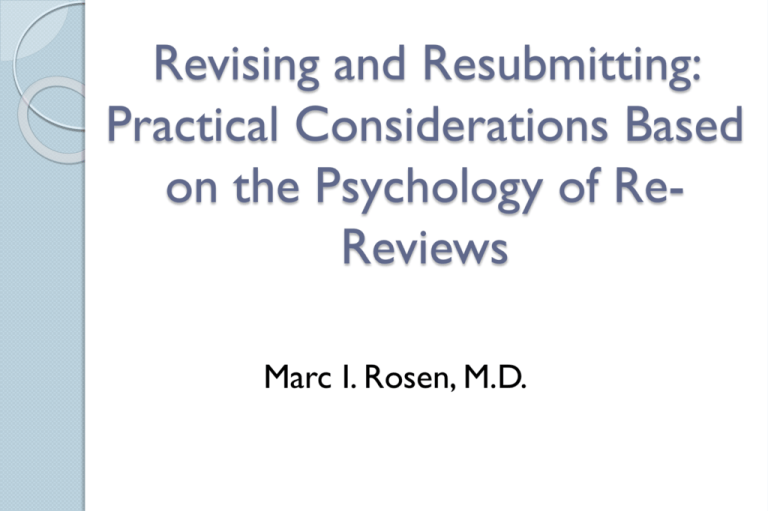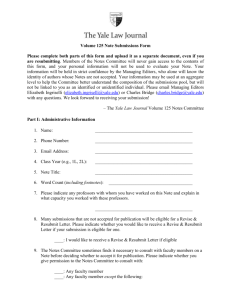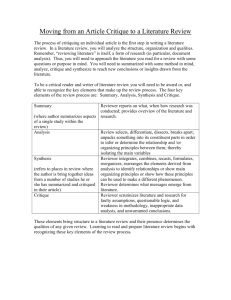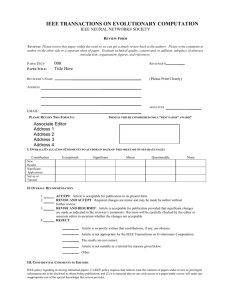Revising and Resubmiting
advertisement

Revising and Resubmitting: Practical Considerations Based on the Psychology of ReReviews Marc I. Rosen, M.D. Most Successful Grants are Revise and Resubmits Initial or Revised? Number Applications Success Rate Initial Submission 19,259 8.6% Revise and Resubmit 5,373 37.2% http://www.report.nih.gov/success_rates/index.aspx 2012 data for new R01s Revising and Resubmitting: Lecture Structure Deciding Whether to Revise and Resubmit Suggestions for Revising and Resubmitting Example Moral Review Group Actions Discussed and Scored with Impact Rating (score and percentile) Triaged/Not Discussed with no Impact Rating but criteria scores (lower half) Deferral; Not Recommended; Abstention Deciding Whether to Resubmit: Consider the Score Triaged/Not Initial decision to triage at meeting rarely overturned at meeting Hard to completely convert a critic to a gungho booster Committee is busy, focuses on close calls 2010-2012 Discussed: How decided? R01s 2.3% of unscored new R01s funded on resubmit 8.7% of unscored continuation R01s funded Includes those not resubmitted http://report.nih.gov/FileLink.aspx?rid=880 Reading the Critiques • Read critiques carefully and calmly • Even if you are angry • Assume you got a good-faith, intelligent review Let colleagues and mentors read the reviews for reality testing, support, and input • Give more weight to comments that • • Are in the “Summary” • Are made by more than one reviewer Deciding Whether to Revise and Resubmit: Get More Information Contact Program Officer -Ask about study section discussion -Ask about NIH Institute interest in area? advice? Talk through reviews with co-investigators and peers Deciding Whether to Resubmit: Keep Perspective • Reviewers assess your submitted material • Reviewers are never totally wrong or right • Extremely competitive process: • Resubmission is common • Avoid WYSIATI (what you see is all there is)---other talented people out there Deciding Whether to Revise and Resubmit: Prospect Theory Sunken Cost Fallacy • Staying to the end of a boring movie hoping to recoup loss of spent money • Using a fitness plan even when it’s painful • It’s a fallacy Loss aversion: It’s not a rejection if you don’t give up Thinking Fast and Slow (Daniel Kahneman) Deciding Whether to Revise and Resubmit: Psychology Overconfidence: Excessive Optimism • • • • Only 5% of U. Chicago MBA students predict they are in bottom 50%; most predict second decile 90% of drivers think they are above average Entrepreneurs say success rate for new business is 50% but predict personal success rate of 100% Few newlyweds expect to be among 50% who eventually divorce Nudge, Thaler and Sunstein Deciding Whether to Revise and Resubmit: Overconfidence? Test of Overconfidence: 90% Confidence Interval for • Weight of earth in tons • 6.0 X 1024 • Percentage of world’s population who are Native English speakers (per CIA World Factbook 2009) • 4.83% Reviews that Should NOT Make You Overconfident “This grant addresses an important topic” “Yale has superb facilities for this research” “The investigator is qualified” Only the first reviewer was critical of the application and the grant was un-scored/poor score Mild praise and the grant was un-scored/poor score Meta-Critiques that May Not be Answerable ”There are already a lot of grants in this area” “Not innovative” “Not significant” “Not exportable” Consider Alternatives A smaller grant (R21 instead of R01) Another funding agency A substantial change that you can submit as a new grant ◦ If you can answer critiques revise and resubmit ◦ If you cannot answer critiques new grant Deciding Whether to Revise and Resubmit • Do you have something better to work on for two-plus months? Revising and Resubmitting: Lecture Structure Deciding Whether to Revise and Resubmit Suggestions for Revising and Resubmitting Examples Moral Consider the Person Behind the Review ◦ Look into research interests of people on the committee ◦ NIH REPORTER search of what committee has funded in the past ◦ Talk to people who have been on the committee ◦ Talk to your project officer Consider the Person Behind the Review ◦ Reviewers want to avoid cognitive dissonance Cognitive dissonance Inner drive to hold our attitudes and beliefs in harmony Drive to avoid dissonance between them Examples The Fox and the Sour Grapes The review group that found fault with your grant ◦ So, don’t say the reviewer was wrong Consider the Person Behind the Review ◦ Even Reviewers Who Change Their Minds Impacted by Anchoring to Prior Score Roulette Wheel Study of Anchoring 1: Volunteers shown rigged roulette wheel that stops at 10 or 65 What % of countries in the U.N. are in Africa? Wheel stops at 10---------25% average Wheel stops at 65---------45% average http://en.wikipedia.org/wiki/Anchoring; Tversky and Kahneman, 1974 Consider the Reviewer’s Perspective The reviewer who likes your application has to justify your response to a committee of 12+ very smart people Make your response easy-to-follow Use tables for complicated concepts (the reviewer can say to the committee—“He’s got a table laying that out.”) Consider the Reviewer’s Perspective • If the reviewer likes the application, he/she is more likely to agree with your justifications • How juries decide: • They do not weigh the evidence • They do arrive at a narrative that appears to fit the data • Answer meta-critiques Revising and Resubmitting: Content Issues Address any grant-killing meta-questions early in your response emphatically and clearly Examples of Meta-Critiques Critique: “They’ll never be able to pull this off – the project is not feasible.” Answers: -Pilot data -Bring in collaborators who can pull it off Examples of Meta-Critiques Critique: “This was written by a slob who just does not know this topic well.” Answers: -Emphasize how much the application has been cleaned up -Consider adding expert who would have caught all your mistakes the first time. Examples of Meta-Critiques Critique: “This was written by Kathy Carroll’s (Stephanie O’Malley’s, Rajita Sinha’s, Marc Potenza’s…) go-fer and is not really an independent application.” Answer: -Spell out what is yours and what is not Examples of Meta-Critiques Critique: “[zzzz’s] always make a hash out of [yyyy] research– it requires someone in my field of specialization. “ “The application would be strengthened by the involvement of a biostatistician.” Answer: -Include someone with the recommended expertise Examples of Meta-Critiques Critique: ”The study design is from hunger.” Answer: -Table and/or figure justifying and explaining the study design Revising and Resubmitting: Process Issues Respond constructively and positively ◦ The reviewer is always right (even if not). No more than 1-2 areas of disagreement, but justify decision thoughtfully and respectfully If not ready to submit at next deadline, DON’T ◦ Reviewers generally need a reason to improve your score Revising and Resubmitting: General Content Issues “Thank you for the careful review of our proposal to […] We appreciate the careful, critiques” Indicate method of highlighting changes (e.g., bold, italics in text) Main criticism and response List more minor criticisms (in italics) and responses “Thank you for reconsidering our application” Revising and Resubmitting: The Best Responses Pilot Data Re-analysis of your own data Literature Revising and Resubmitting: Weaker Responses ◦ Logic ◦ Your opinion ◦ “In my clinical experience…” Revising and Resubmitting: Don’t, Don’t, Don’t (Usually) don’t answer questions that were not raised Don’t malign the review process or the reviewer Don’t spend much effort pointing out that one reviewer liked what another reviewer critiqued If the reviewer asks for something that was already in the application, be humble, e.g. “The information is presented more clearly this time in the methods as follows…” Don’t get personal (no jokes, personal opinions, etc.) Revising and Resubmitting: Don’t, Don’t, Don’t • Don’t repeat every critical word from a review • Summarize criticisms (it was bad enough the first time) • Don’t over-answer minor criticisms by writing a long essay that makes the criticism seem more major than it is Revising and Resubmitting: Lecture Structure Deciding Whether to Revise and Resubmit Suggestions for Revising and Resubmitting Example Moral Example of Grant Review 4-year clinical trial to test computerdelivered counseling to improve engagement in work Grant Review • • • Lousy score of 270, 67th percentile Program officer tells me they liked it, wanted to see it back Reviewer response: • Reviewer one liked • Reviewer two mixed • Reviewer three (statistician) gave it terrible score Reviewer’s Potentially GrantKilling Responses “However, no data exists whether veterans would actually use the intervention.” Summary Statement Recommends “Further conceptually develop and pilot test the internet-based intervention. Provide that data as a part of the proposal.” Planned Response • Agree with everything reviewers say and propose three-year, pilot-type, therapy development study to address it Revising and Resubmitting: Lecture Structure Deciding Whether to Revise and Resubmit Suggestions for Revising and Resubmitting Example Moral Morals It helps to enjoy the process ◦ Doing your best ◦ Advocating for something you believe in ◦ Promoting yourself Your CV lists grants ◦ No lasting harm from unfunded application Moral “At the length, truth will out” ◦ Shakespeare (Merchant of Venice) “In the long run, we are all dead.” ◦ John Maynard Keynes Thank you






